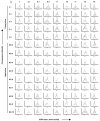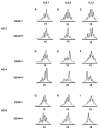Clonal expansions and loss of receptor diversity in the naive CD8 T cell repertoire of aged mice
- PMID: 19124721
- PMCID: PMC2724652
- DOI: 10.4049/jimmunol.182.2.784
Clonal expansions and loss of receptor diversity in the naive CD8 T cell repertoire of aged mice
Abstract
There are well-characterized age-related changes in the peripheral repertoire of CD8 T cells characterized by reductions in the ratio of naive:memory T cells and the development of large clonal expansions in the memory pool. In addition, the TCR repertoire of naive T cells is reduced with aging. Because a diverse repertoire of naive T cells is essential for a vigorous response to new infections and vaccinations, there is much interest in understanding the mechanisms responsible for declining repertoire diversity. It has been proposed that one reason for declining repertoire diversity in the naive T cell pool is an increasing dependence on homeostatic proliferation in the absence of new thymic emigrants for maintenance of the naive peripheral pool. In this study, we have analyzed the naive CD8 T cell repertoire in young and aged mice by DNA spectratype and sequence analysis. Our data show that naive T cells from aged mice have perturbed spectratype profiles compared with the normally Gaussian spectratype profiles characteristic of naive CD8 T cells from young mice. In addition, DNA sequence analysis formally demonstrated a loss of diversity associated with skewed spectratype profiles. Unexpectedly, we found multiple repeats of the same sequence in naive T cells from aged but not young mice, consistent with clonal expansions previously described only in the memory T cell pool. Clonal expansions among naive T cells suggests dysregulation in the normal homeostatic proliferative mechanisms that operate in young mice to maintain diversity in the naive T cell repertoire.
Figures






Similar articles
-
The influence of age on T cell generation and TCR diversity.J Immunol. 2005 Jun 1;174(11):7446-52. doi: 10.4049/jimmunol.174.11.7446. J Immunol. 2005. PMID: 15905594
-
Diversity and clonal selection in the human T-cell repertoire.Proc Natl Acad Sci U S A. 2014 Sep 9;111(36):13139-44. doi: 10.1073/pnas.1409155111. Epub 2014 Aug 25. Proc Natl Acad Sci U S A. 2014. PMID: 25157137 Free PMC article.
-
Age-related dysregulation in CD8 T cell homeostasis: kinetics of a diversity loss.J Immunol. 2000 Sep 1;165(5):2367-73. doi: 10.4049/jimmunol.165.5.2367. J Immunol. 2000. PMID: 10946259
-
CD8+ T cell differentiation in the aging immune system: until the last clone standing.Curr Opin Immunol. 2011 Aug;23(4):549-54. doi: 10.1016/j.coi.2011.05.002. Epub 2011 Jun 12. Curr Opin Immunol. 2011. PMID: 21664807 Review.
-
Non-malignant clonal expansions of CD8+ memory T cells in aged individuals.Immunol Rev. 2005 Jun;205:170-89. doi: 10.1111/j.0105-2896.2005.00265.x. Immunol Rev. 2005. PMID: 15882353 Review.
Cited by
-
Defective CD8 T cell responses in aged mice are due to quantitative and qualitative changes in virus-specific precursors.J Immunol. 2012 Feb 15;188(4):1933-41. doi: 10.4049/jimmunol.1101098. Epub 2012 Jan 13. J Immunol. 2012. PMID: 22246631 Free PMC article.
-
Uremia-Associated Immunological Aging and Severity of COVID-19 Infection.Front Med (Lausanne). 2021 Apr 14;8:675573. doi: 10.3389/fmed.2021.675573. eCollection 2021. Front Med (Lausanne). 2021. PMID: 33937299 Free PMC article. Review.
-
Age-related changes in CD8 T cell homeostasis and immunity to infection.Semin Immunol. 2012 Oct;24(5):356-64. doi: 10.1016/j.smim.2012.04.009. Epub 2012 May 1. Semin Immunol. 2012. PMID: 22554418 Free PMC article. Review.
-
T-cell immunosenescence: lessons learned from mouse models of aging.Trends Immunol. 2009 Jul;30(7):301-5. doi: 10.1016/j.it.2009.04.007. Epub 2009 Jun 21. Trends Immunol. 2009. PMID: 19541537 Free PMC article. Review.
-
A B-cell subset uniquely responsive to innate stimuli accumulates in aged mice.Blood. 2011 Aug 4;118(5):1294-304. doi: 10.1182/blood-2011-01-330530. Epub 2011 May 11. Blood. 2011. PMID: 21562046 Free PMC article.
References
-
- Linton PJ, Dorshkind K. Age-related changes in lymphocyte development and function. Nat Immunol. 2004;5:133–139. - PubMed
-
- Murasko DM, Jiang J. Response of aged mice to primary virus infections. Immunol Rev. 2005;205:285–296. - PubMed
-
- Grubeck-Loebenstein B, Wick G. The aging of the immune system. Adv Immunol. 2002;80:243–284. - PubMed
-
- Miller RA. Aging and immune function. Int Rev Cytol. 1991;124:187–215. - PubMed
-
- Miller RA. The aging immune system: primer and prospectus. Science. 1996;273:70–74. - PubMed
Publication types
MeSH terms
Substances
Grants and funding
LinkOut - more resources
Full Text Sources
Other Literature Sources
Medical
Research Materials

